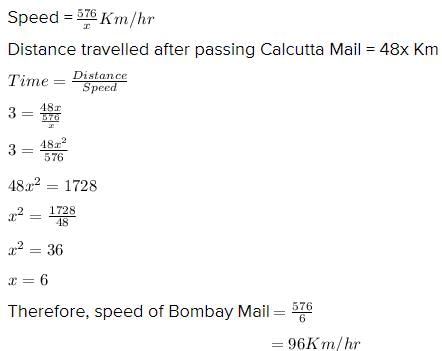Test: Speed, Time & Distance - 4 - UPSC MCQ
15 Questions MCQ Test UPSC Prelims Paper 2 CSAT - Quant, Verbal & Decision Making - Test: Speed, Time & Distance - 4
An express train travelled at an average speed of 100 km/hr stopping for 3 minutes after every 75 km. How long did it take to reach its destination 600 km from the starting point ?
Ram and Bharat travel the same distance at the rate of 6 km per hour and 10 km per hourrespectively. If Ram takes 30 minutes longer than Bharat, the distance travelled by each is
Two trains, Calcutta Mail and Bombay Mail, start at the same time from stations Kolkata and Mumbai respectively towards each other. After passing each other, they take 12 hours and 3 hoursto reach Mumbai and Kolkata respectively. If the Calcutta Mail is moving at the speed of 48 km/h,the speed of the Bombay Mail is
Walking at 3/4 of his normal speed, a man takes 2(1/2) hours more than the normal time. Find thenormal time.
Sambhu beats Kalu by 30 metres in 10 seconds. How much time was taken by Sambhu tocomplete a race 1200 meters.
Without stoppage, a train travels a certain distance with an average speed of 60 km/h, and withstoppage, it covers the same distance with an average speed of 40 km/h. On an average, howmany minutes per hour does the train stop during the journey?
Rishikant, during his journey, travels for 20 minutes at a speed of 30 km/h, another 30 minutes at aspeed of 50 km/h, and 1 hour at a speed of 50 km/h and 1 hour at a speed of 60 km/h. What is theaverage velocity?
Narayan Murthy walking at a speed of 20 km/h reaches his college 10 minutes late. Next time he increases his speed by 5 km/h, but finds that he is still late by 4 minutes. What is the distance ofhis college from his house?
A motor car does a journey in 17.5 hours, covering the first half at 30 km/h and the second half at 40 km/h. Find the distance of the journey.
Manish travels a certain distance by car at the rate of 12 km/h and walks back at the rate of 3km/h. The whole journey took 5 hours. What is the distance he covered on the car?
A car driver, driving in a fog, passes a pedestrian who was walking at the rate of 2 km/h in thesame direction. The pedestrian could see the car for 6 minutes and it was visible to him up to adistance of 0.6 km. What was the speed of the car?
A journey of 192 km takes 2 hours less by a fast train than by a slow train. If the average speed of the slow train be 16 kmph less than that of fast train, what is the average speed of the faster train?
If Arun had walked 1 km/h faster, he would have taken 10 minutes less to walk 2 kilometre. What is Arun’s speed of walking?
A cyclist moving on a circular track of radius 100 metres completes one revolution in 2 minutes.What is the average speed of cyclist (approximately)?
A car travels 1/3 of the distance on a straight road with a velocity of 10 km/h, the next 1/3 with a velocity of 20 km/h and the last 1/3 with a velocity of 60 km/h. What is the average velocity of thecar for the whole journey?
|
67 videos|50 docs|151 tests
|
|
67 videos|50 docs|151 tests
|



















